ISS: BEAM (Bigelow Expandable Activity Module)
Non-EO
NASA
Quick facts
Overview
| Mission type | Non-EO |
| Agency | NASA |
| Launch date | 08 Apr 2016 |
ISS Utilization: BEAM (Bigelow Expandable Activity Module)
Launch Mission Status References
In January 2013, NASA awarded a contract to the commercial company Bigelow Aerospace of North Las Vegas, NV, to buy a Bigelow Aerospace expandable habitat and attach it to the ISS (International Space Station) for a two-year test flight. The prototype, called BEAM (Bigelow Expandable Activity Module), is scheduled to fly in 2015 aboard a SpaceX (Space Exploration Technologies Corporation) Dragon cargo resupply mission.
NASA's partnership with Bigelow opens a new chapter in the continuing work to bring the innovation of industry to space, heralding cutting-edge technology that can allow humans to thrive in space safely and affordably. Funding for the Bigelow prototype, a windowless, pumpkin-shaped module about the size of a large walk-in closet, comes not from the space station program, but from NASA’s AES (Advanced Exploitation Systems) program budget. 1) 2) 3) 4)
Research overview:
• Increase the TRL (Technology Readiness Level) for Inflatable System to 9 (Flight Demonstration). This Flight Demonstration also drives TRL increase of certain technology areas like Soft goods materials to 8.0.
• Demonstrate launch and deployment of a commercial inflatable structure. Implement folding and packaging techniques for inflatable payloads. Implement a venting system for inflatable shell during ascent to the ISS.
• Determine radiation protection capability of inflatable structures.
• Demonstrate design performance of Commercial inflatable structure like thermal, structural, mechanical durability, long term leak performance etc.
• Demonstrate safe deployment and operation of an inflatable structure in a flight mission.
The BEAM module’s skin is made up of multiple layers of soft goods. The different layers of BEAM from inside to outside consist of the air barrier (bladder), restraint, MMOD (Micro-meteoroid and Orbital Debris) layers, External MLI layers and an exterior BETA cloth. The restraint provides the primary structural load bearing member of the BEAM module. The MMOD shield is designed and tested to the LEO (Low Earth Orbit) environment. The shield is designed to stop potential particles from breaching into the primary structural restraint layer and the gas bladder. The probability of penetration is extremely low. In the very unlikely event of a penetration, the BEAM would slowly leak instead of bursting. It is designed in this manner to preclude any damage to the rest of ISS. Another desirable feature of the fabric skin of BEAM is its ability to better absorb noise for a quieter habitable volume than the aluminum walls of the ISS modules. The BEAM investigation runs two years. During this test period, BEAM is not used for storage and is not occupied. The module is constantly monitored for temperature, pressure, and radiation, and ISS crew periodically (four times per year) enter the module to collect data and check on its structural condition. After two years of testing, BEAM is released from ISS to burn up on reentry into the atmosphere. 5)
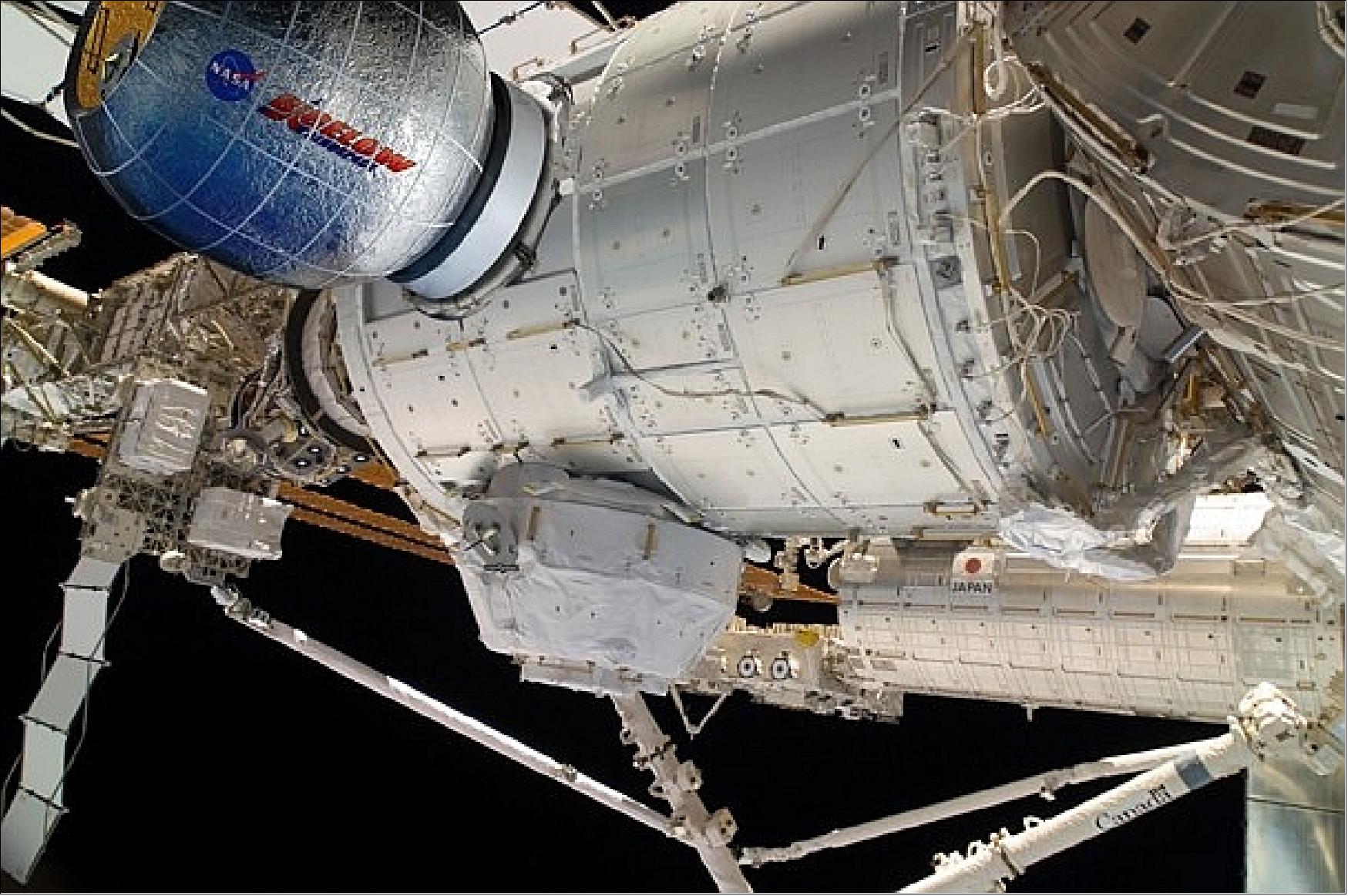
Both NASA and Bigelow stand to gain from putting an inflatable module on the ISS. Given the fact that inflatable modules could play a major role in any future NASA interplanetary spacecraft or surface base, NASA could gain valuable in-flight data from an inflatable module on ISS, as well as much-needed stowage space. Bigelow would gain confidence in – and operational experience with – its inflatable modules in a crewed environment, confidence which would undoubtedly also be gained by any potential future customers to Bigelow. Given that the ISS is a permanently crewed operational environment, it is an ideal testbed to demonstrate these technologies. 6)
Already in January 2011, the ISSP (International Space Station Program) managers at NASA/JSC ( Johnson Space Center) in Houston held a two-day technical meeting to discuss the prospect of adding a Bigelow Aerospace inflatable module to the ISS. A proposal for an inflatable module on the ISS was outlined at NASA’s Exploration Enterprise Workshop, which was held in Galveston, TX, in May 2010 (Ref. 6). 7) 8)
Lightweight fabric structures that can be expanded in orbit offer huge cost savings over comparably sized but heavier metal spacecraft, which are more expensive to launch.
BEAM, for example, has a launch mass of about 1,413 kg, but expands to about 4 m in length and 3.2 m in diameter to provide about 16 m3 of interior space.
Some background on the development of Bigelow Aerospace inflatable structures: 9) 10) 11) 12)
• In the late 1990s, NASA was engaged in the development of TransHab, a large inflatable habitat in space who's multi-layer shell was based on Kevlar high-strength fibers (TransHab requirements called for an inflated volume of 340 m3 , 11 m in length and 4.3 m in diameter, and a launch mass of 13,200 kg) for protection from orbital and meteoroid debris. TransHab was intended as a replacement for the already existing rigid International Space Station crew habitation module. However, the US Congress (and NASA) cancelled the TransHab project in 2000 due to budgetary constraints. 9) 10)
• Bigelow Aerospace was founded by Robert Bigelow in 1998. The company is a pioneering world leader in the area of expandable space station modules.
• In 2002, Bigelow Aerospace signed a NASA Space Act Agreement contract with the Technology Transfer and Commercialization Office of NASA/JSC. That agreement (exclusive license) enabled the private group and NASA to work together on evaluating next generation inflatable/expandable space module technology. Thus, Bigelow Aerospace started to pursue a development scheme for a civilian space complex - using the patents developed by NASA. The TransHab concept originated at NASA/JSC in 1997 as a possible design for inflatable living quarters on future Mars-bound spacecraft, and was led by William Schneider who became a Bigelow Aerospace consultant after his retirement from NASA. 11)
• Bigelow Aerospace launched the Genesis-1 and Genesis-2 inflatable pathfinder modules (each of 11.5 m3 volume) in 2006 and 2007, respectively, after licensing the patent from NASA, gaining long-term experience in the handling and operation of these structures in the LEO (Low Earth Orbit) space environment. Both spacecraft modules, Genesis-1 and Genesis-2, are “operating nominally” in 2015.
- One of the greatest benefits of using inflatable habitats is the protection offered to its inhabitants from radiation. When spacecraft made from more conventional metal structures are exposed to radiation, from events such as a coronal mass ejection, a secondary radiation effect occurs. This can either be from scattering of the radiation, or the atoms in the structure itself can become excited and re-radiate. This doesn't happen with non-metallic materials used in inflatable craft outer skins thereby significantly reducing the risk to its inhabitants.
- At the heart of the inflatable technology is a material called Vectran, twice as strong as Kevlar and present in several layers of the 15cm thick skin of the Genesis craft. The flexible nature of the material results in further added safety for potential station inhabitants, a benefit supported by laboratory tests. It was found that micrometeoroids that would puncture the rigid skin of the International Space Station only penetrated half way through the skin of the Genesis craft (Ref. 12).
- As a consequence of these very positive results gained with Genesis-1 and Genesis-2, NASA is confident that the ISS is a uniquely suited test bed to demonstrate innovative exploration technologies like the BEAM endeavor. Habitats that allow for long-duration stays in space will be a critical capability.
• Expandable habitats could be a new way to dramatically increase the amount of volume available to astronauts while also enhancing protection against radiation and physical debris. Innovative advances in efficiency provided by expandable habitats may give the nation new options for extending human presence farther into the solar system, both in transit and on the surface of other worlds, while also supporting the development of innovative platforms for commercial use in low-Earth orbit.
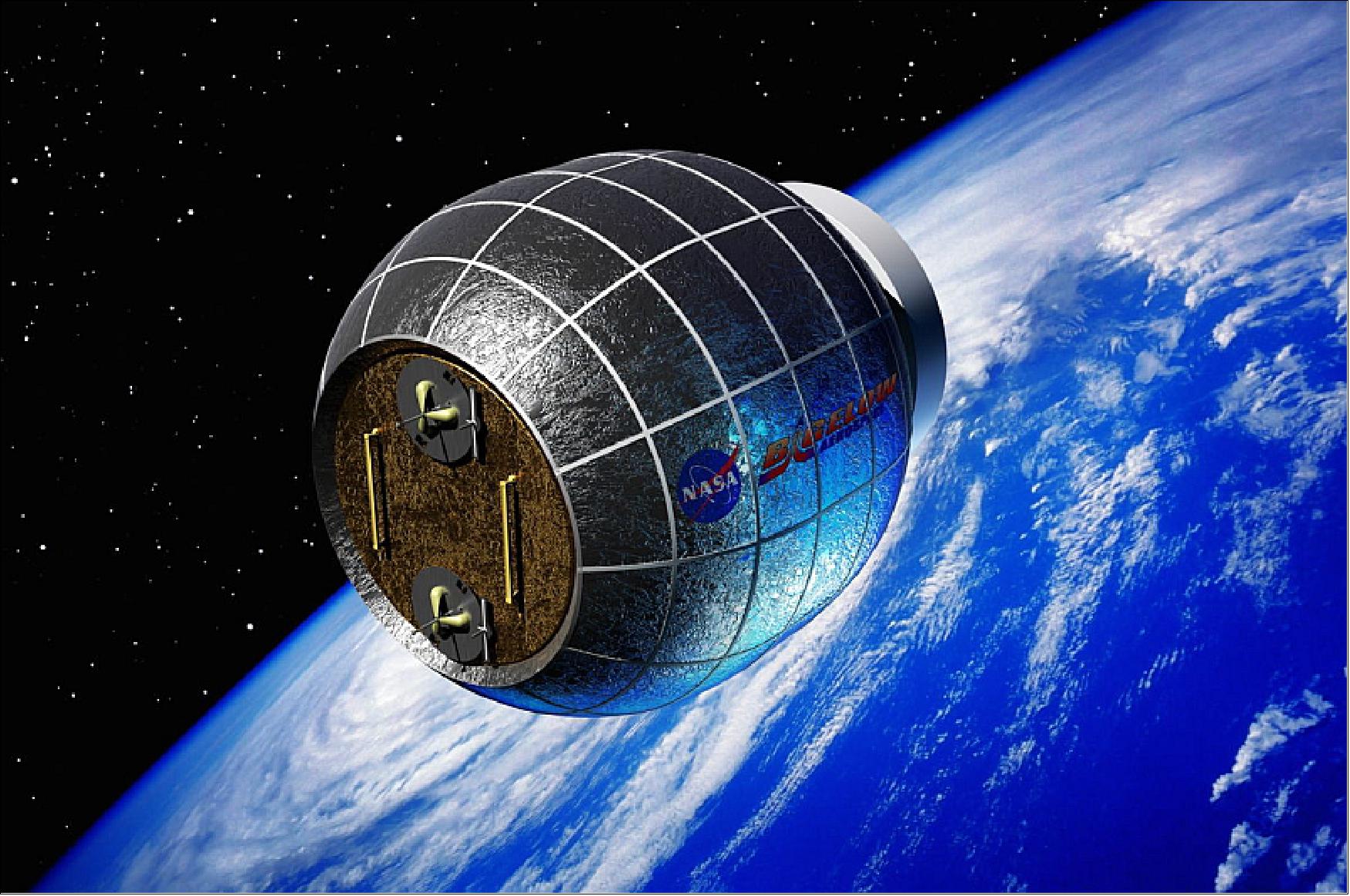
Packed Configuration | Expanded Configuration |
Mass: 1,400 kg | Mass: 1,400 kg |
Development Status
• April 27, 2023: The International Space Station (ISS) partners have agreed to extend the operational period of the ISS. The United States, Japan, Canada and participant European Space Agency (ESA) countries will support operations until 2030, while Russia has committed to continuing station operations until 2028. 29)
• March 12, 2015 marked the public debut of the BEAM (Bigelow Expandable Activity Module), which Bigelow Aerospace built under the terms of a $17.8 million contract with NASA. Within the next few months, the BEAM module is due to be trucked east to Florida for processing. It'll be launched as early as September from Cape Canaveral Air Force Station, aboard a robotic SpaceX Dragon cargo capsule. 14) 15) 16)
- The Dragon will deliver BEAM to the space station in its folded-up, 1.5 m x 2 m configuration. Astronauts will use the station's robotic arm to attach the module to a docking port on the U.S.-built Tranquility node . Once the module is attached to the ISS it will undergo a series of tests to ensure the supporting hardware is safe for use. The crew aboard the space station will activate a pressurization system that will allow the structure to expand to its full size (about the size of a large camping tent) using air stored within the module.
NASA plans to unfold it into the outer-space equivalent of a recreation room. This could be a very nice module potentially for the crews to go hang out in. ... It may become a very popular place (William Gerstenmaier).
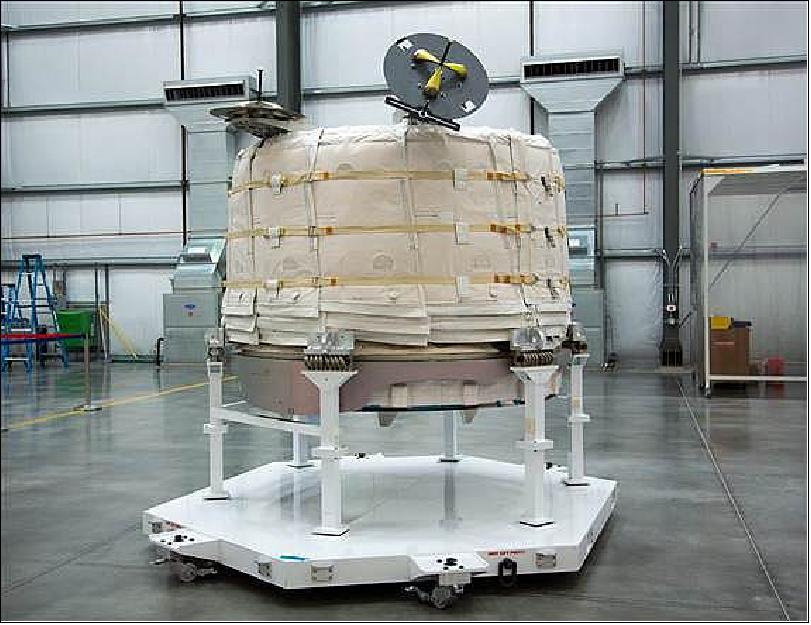
- NASA will conduct two years' worth of tests to determine how well the module holds pressure, how much protection it provides from space radiation and how resilient it is to impacts with tiny bits of orbital debris.
- If the experimental module works out the way NASA and Bigelow Aerospace hope it does, we could be seeing even bigger and better expandable spacecraft, including monster space blimps that have twice as much volume as the International Space Station.
Launch
BEAM was launched to the ISS on a Falcon-9 v1.1 Dragon vehicle on April 8, 2016 as part of SpaceX's CRS-8 (Cargo Resupply Services-8) mission. The flight delivered a total cargo mass of 3175 kg. 17)
Orbit: Near-circular orbit , initial altitude of about 400 km, inclination 51.6º.
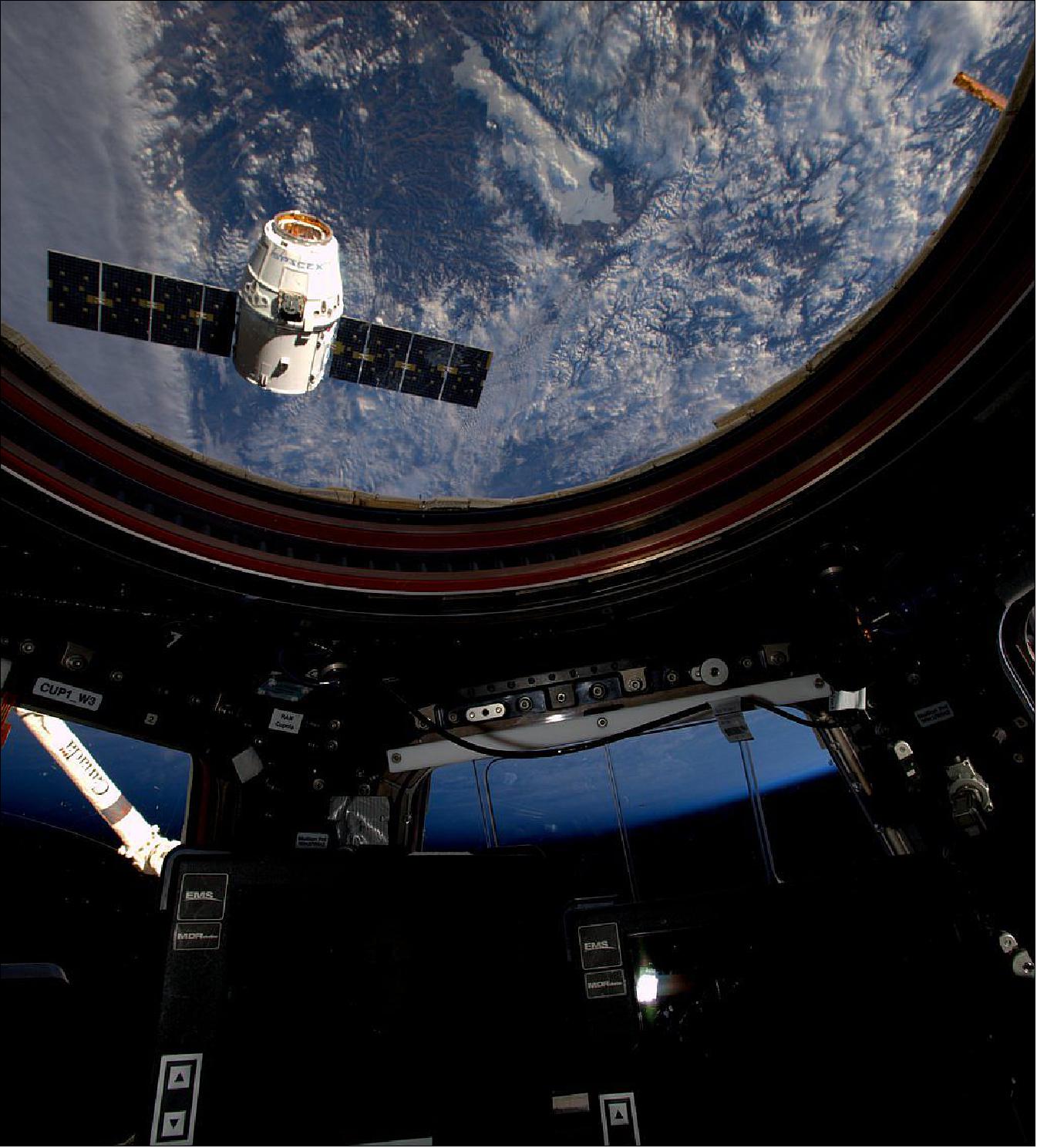
Mission Status
• January 21, 2022: NASA has hired a new company to provide engineering support for an inflatable module on the International Space Station originally built and managed by Bigelow Aerospace. 18)

- In a Jan. 18 procurement filing, NASA announced it awarded a $250,000 contract to ATA Engineering of San Diego, California, to provide engineering support services for the Bigelow Expandable Activity Module (BEAM), an inflatable module added to the station in 2016. The module was built by Bigelow Aerospace, which had provided support for the module until December.
- NASA announced Dec. 10 its intent to award a sole-source contract with ATA Engineering to handle those engineering services. That company, the agency said, was the only one qualified to provide that support given its role as a subcontractor to Bigelow in the development of BEAM and later support of operations of the module, including engineering analyses that confirmed the module’s life could be extended to as late as 2032.
- In that earlier notice, NASA said that Bigelow “transferred title and ownership of the BEAM to NASA Johnson Space Center” in December as its engineering contract expired. NASA spokesperson Leah Cheshier said at the time that the transfer of ownership was one of the terms of the sustaining engineering contract NASA awarded Bigelow in 2017, and involved no exchange of funding or other considerations between NASA and Bigelow.
- Bigelow Aerospace, founded more than 20 years ago, was a pioneer in the development of inflatable module technology and planned to use it for a series of space stations. In addition to BEAM, the company launched two prototype inflatable modules, Genesis 1 and 2, in 2006 and 2007, respectively. It had been working on a much larger module called B330 because it had a volume of 330 cubic meters when fully expanded.
- Bigelow, though, declined to bid on a NASA competition to install a commercial module on the ISS, saying the funding offered by the agency was insufficient to close its business case. NASA selected Axiom Space in January 2020 to develop a commercial module to be installed on the station as soon as 2024.
- In March 2020, Bigelow Aerospace laid off its entire workforce, citing restrictions imposed by the Nevada state government in the early weeks of the pandemic that closed nonessential businesses. The company has not made any public comments about its future since then. It notably was not among the “interested parties” that participated in meetings last year for NASA’s Commercial Low Earth Orbit Destinations program to support development of commercial space stations, and was not a part of any of the three teams that received NASA awards in December.
Inflatable “Entertainment” Module Proposed for ISS
- BEAM, though, may not be the only inflatable module on the ISS in the future. A British company, Space Entertainment Enterprise (SEE), announced Jan. 20 it is working with Axiom Space to add an inflatable module to Axiom’s commercial segment of the station.
- The SEE-1 module is envisioned as a spherical module six meters across when fully expanded, attached to a docking port on the initial Axiom commercial module added to the station. SEE said that module would be operational in December 2024, which would be around the time the Axiom module itself is added to the station.
- SEE envisions using the module as entertainment facility for music, film and sports events. “With worldwide leader Axiom Space building this cutting-edge, revolutionary facility, SEE-1 will provide not only the first, but also the supreme quality space structure enabling the expansion of the two trillion-dollar global entertainment industry into low Earth orbit,” said Dmitry and Elena Lesnevsky, co-founders of SEE, in a statement.
- “Adding a dedicated entertainment venue to Axiom Station’s commercial capabilities in the form of SEE-1 will expand the station’s utility as a platform for a global user base and highlight the range of opportunities the new space economy offers,” Michael Suffredini, president and chief executive of Axiom Space, said in the statement. Axiom will build the module for SEE.
- SEE provided few details about their plans or their ability to fund development of the module. The company claimed in its statement to have several former media executives as consultants and advisers, but did not name them. It also said it is working with GH Partners, an investment bank based in New York, on a fundraising round, but did not disclose how much money it was raising or how much development of SEE-1 would cost.
- According to business filings, SEE was incorporated in Britain in August 2020 as “Space Fighting League” and changed its name last year to Space Entertainment Enterprise. The company has not disclosed any financial information and has Dmitry and Elena Lesnevsky as its sole directors.
- The SEE release also claimed that Dmitry and Elena Lesnevsky “are producing the first ever Hollywood motion picture filmed in outer space,” linking to a page on the Internet Movie Database (IMDb) website named “Untitled Tom Cruise/SpaceX Project.” That page lists the Lesnevskys as producers along with actor Tom Cruise and SpaceX Chief Executive Elon Musk, among others.
- It’s unclear why and how the Lesnevskys are involved in the project. Dmitry Lesnevsky’s own IMDb profile states that the last film he produced was Turnaround, an eight-minute film released in 2016 that cost an estimated £20,000 ($27,000). Elena Lesnevsky is not credited with producing any films released to date.
- Cruise, one of the world’s most famous actors, has long been associated with a feature film on the International Space Station, and in 2020 then-NASA Administrator Jim Bridenstine confirmed that the agency was in discussions with Cruise about filming a movie on the station. There’s been little public progress since then on any effort to do so.
- It’s unlikely, even if producers secure funding and other approvals, that the movie could be filmed before 2023. The first NASA-backed private astronaut mission to the ISS, Axiom Space’s Ax-1, is now scheduled to launch March 31 after a one-month delay that the agency and company said Jan. 18 is to “account for additional spacecraft preparations and space station traffic.” None of the four people on that mission have announced any plans for filmmaking.
- Axiom Space has not yet disclosed the full crew for its second private astronaut mission, Ax-2. Phil McAlister, director of the commercial space division at NASA Headquarters, told an advisory committee Jan. 19 that Ax-2 is now expected to fly no sooner than early 2023.
• December 4, 2017: BEAM will remain attached to the International Space Station to provide additional performance data on expandable habitat technologies and enable new technology demonstrations. NASA awarded a sole-source contract to Bigelow Aerospace to support extension of the life of the privately-owned module, and its use to stow spare space station hardware. 19)
- After NASA and Bigelow successfully completed collaborative analyses on BEAM life extension and stowage feasibility, astronauts began the process to provide additional storage capability aboard the station by removing hardware used for the initial BEAM expansion. They then converted sensors that monitor the BEAM environment from wireless to wired (to prevent interference from future stowage items on transmission of sensor data). Next they installed air ducting, netting, and large empty bags to define the stowage volume for hardware inside BEAM. NASA and Bigelow later will likely add a power and data interface to BEAM, which will allow additional technology demonstrations to take place for the duration of the partnership agreement.
- This new contract, which began in November, will run for a minimum of three years, with two options to extend for one additional year. At the end of the new contract, the agency may consider another extension or could again consider jettisoning BEAM from the station.
- The space inside BEAM will hold up to 130 Cargo Transfer Bags of in-orbit stowage. Long-term use of BEAM will enable NASA and Bigelow to gather additional performance data on the module’s structural integrity and thermal stability and resistance to space debris, radiation, and microbial growth, to help NASA advance and learn about expandable space habitat technology in low-Earth orbit for application toward future human exploration missions. Using BEAM for stowage will free up about 0.53 m3/bag of space in other station modules for research.
- NASA’s use of BEAM as part of a human-rated system allows Bigelow Aerospace to demonstrate its technology for future commercial applications in LEO. Initial studies have shown that soft materials can perform as well as rigid materials for habitation volumes in space and that BEAM has performed as designed in resistance to space debris.
- BEAM launched on the eighth SpaceX Commercial Resupply Service mission in 2016. After being attached to the Tranquility Node using the station’s robotic Canadarm2, it was filled with air to expand it for a two-year test period to validate overall performance and capability of expandable habitats. Since the initial expansion, a suite of sensors installed by the crew automatically take measurements and monitor BEAM’s performance to help inform designs for future habitat systems. This extension will deepen NASA’s understanding of expandable space systems by making the BEAM a more operational element of the space station to be actively used in storage and crew operations.
- Space station crew members have entered BEAM more than a dozen times since its expansion in May 2016. The crew has conducted radiation shielding experiments, installed passive radiation badges called Radiation Area Monitors, and routinely collect microbial air and surface samples. These badges and samples are returned to Earth for standard microbial and radiation analysis at the Johnson Space Center.
- The public-private partnership between NASA and Bigelow supports NASA’s objective to develop deep space habitation capabilities for human missions beyond Earth orbit while fostering commercial capabilities for non-government applications to stimulate the growth of the space economy.

• October 3, 2017: NASA is exploring options with Bigelow Aerospace to extend the life of the privately owned Bigelow Expandable Activity Module. Known as BEAM, the module is attached to the International Space Station and continues to perform well during its technology demonstration mission. NASA has issued a synopsis of an intended contract action to partner with Bigelow Aerospace to extend the life of the expandable habitat and use it for long-term in-orbit storage. This step continues NASA’s commitment to expand private-public partnerships, scientific research and commercial applications aboard station to maximize the benefits from humanity’s premiere laboratory in microgravity. 20)
- NASA’s use of BEAM as part of a human-rated system will allow Bigelow Aerospace to demonstrate its technology for future commercial applications in low-Earth Orbit. Initial studies have shown that soft materials can perform as well as rigid materials for habitation volumes in space and that BEAM has performed as designed in resistance to space debris.
- BEAM launched on the eighth SpaceX Commercial Resupply Service mission in 2016. After being attached to the Tranquility Node using the station’s robotic Canadarm2, it was filled with air to expand it for a two-year test period to validate overall performance and capability of expandable habitats. Since the initial expansion, a suite of sensors installed by the crew automatically take measurements and monitor BEAM’s performance to help inform designs for future habitat systems. Learning how an expandable habitat performs in the thermal environment of space and how it reacts to radiation, micrometeoroids and orbital debris will provide information to address key concerns about living in the harsh environment of space. This extension activity will deepen NASA’s understanding of expandable space systems by making the BEAM a more operational element of the space station to be actively used in storage and crew operations.
- Space station crew members have entered BEAM 13 times since its expansion in May 2016. The crew has conducted radiation shielding experiments, installed passive radiation badges called Radiation Area Monitors, and they routinely collect microbial air and surface samples. These badges and samples are returned to Earth for standard microbial and radiation analysis at the Johnson Space Center.
- The original plan called for engineers to robotically jettison BEAM from the space station following the two-year test and validation period, allowing it to burn up during its descent through Earth’s atmosphere. However, after almost a year and a half into the demonstration with positive performance, NASA now intends to continue supporting BEAM for stowage use and to allow Bigelow Aerospace to use the module as a test-bed for new technology demonstrations. A new contract would likely begin later this year, overlapping the original planned test period, for a minimum of three years, with two options to extend for one additional year. At the end of the new contract, the agency may consider further life extension or could again consider jettisoning BEAM from the station.
- Using the space inside BEAM would allow NASA to hold between 109 to 130 Cargo Transfer Bags of in-orbit stowage, and long-term use of BEAM would enable NASA to gather additional performance data on the module’s structural integrity, thermal stability and resistance to space debris, radiation and microbial growth to help NASA advance and learn about expandable space habitat technology in low-Earth orbit for application toward future human exploration missions. Given that the volume of each Cargo Transfer Bag is about 1.87 cubic feet (0.53 cubic meters), use of BEAM for stowage will free an equivalent space of about 3.7 to 4.4 International Standard Payload Racks, enabling more space in the ISS for research.
- With an extension of the partnership, Bigelow also would be able to continue to demonstrate its technology for future commercial applications in low-Earth orbit. The public-private partnership between NASA and Bigelow supports NASA’s objective to develop deep space habitation capabilities for human missions beyond Earth orbit while fostering commercial capabilities for non-government applications to stimulate the growth of the space economy.
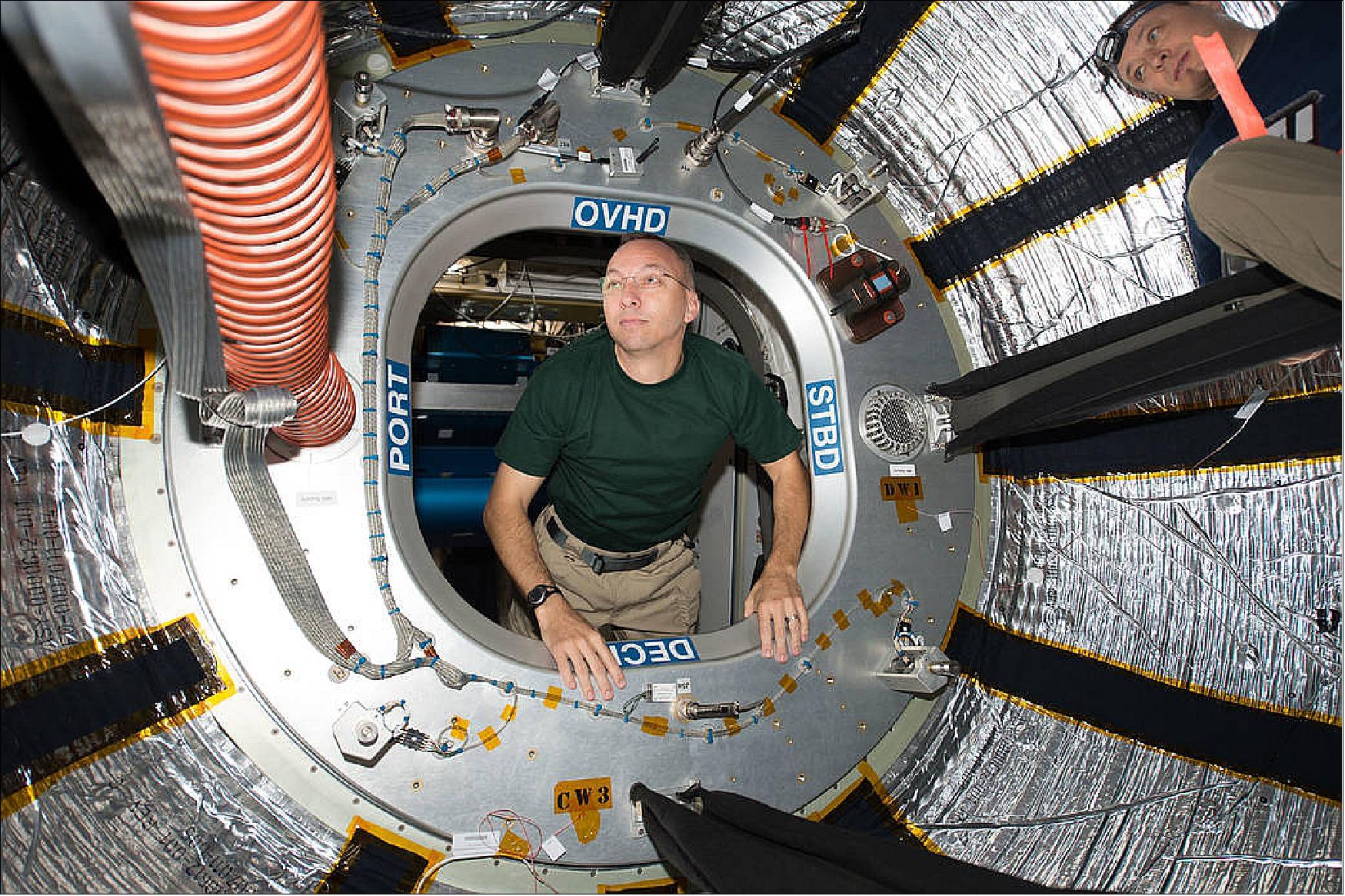
• May 26, 2017: Halfway into its planned two-year demonstration attached to the International Space Station, the BEAM (Bigelow Expandable Activity Module) is showing that soft materials can perform as well as rigid materials for habitation volumes in space. The BEAM was launched and attached to station through a partnership between NASA’s AES (Advanced Exploration Systems) Division and Bigelow Aerospace, headquartered in North Las Vegas, Nevada. 22)
- NASA and Bigelow are primarily evaluating characteristics directly related to the module’s ability to protect humans from the harsh space environment. Astronauts aboard station work with researchers on the ground to monitor the module’s structural integrity, thermal stability, and resistance to space debris, radiation, and microbial growth.
- Researchers at NASA’s Langley Research Center in Hampton, Virginia, continually analyze data from internal sensors designed to monitor and locate external impacts by orbital debris, and, as expected, have recorded a few probable micrometeoroid debris impacts so far. BEAM has performed as designed in preventing debris penetration with multiple outer protective layers exceeding space station shielding requirements.
- Over the next several months, NASA and Bigelow will focus on measuring radiation dosage inside the BEAM. Using two active REMs (Radiation Environment Monitors) inside the module, researchers at NASA/JSC (Johnson Space Center) in Houston are able to take real-time measurements of radiation levels. They have found that GCR (Galactic Cosmic Radiation) dose rates inside the BEAM are similar to other space station modules, and continue to analyze contributions to the daily dose from the Earth’s trapped radiation belts to better understand the shielding properties of the module for application to long-term missions. The space station and the BEAM enjoy a significant amount of protection from Earth’s magnetosphere. Future deep space missions will be far more exposed to energized radiation particles speeding through the solar system, so NASA is actively working on ways to mitigate the effects of radiation events.
- In late April, NASA’s radiation researchers at Johnson began a multi-month BEAM radiation experiment by installing a 1.1 mm thick shield onto one of the two REM sensors in BEAM. The station crew produced a hemispherical shield using the 3D printer on the space station, and in the next few months this first shield will be replaced by two successively thicker shields, also 3D printed, with thicknesses of about 3.3mm and 10mm, respectively. The difference in measurements from the two REMs—one with a shield and one without—will help better resolve the energy spectra of the trapped radiation particles, particularly those coming from the SAA (South Atlantic Anomaly).
- Space station crew members have entered the BEAM nine times since its expansion in May 2016. In addition to the REM shielding experiment activities, the crew has swapped out passive radiation badges called Radiation Area Monitors and they routinely collect microbial air and surface samples. These badges and samples are sent back to Earth for standard microbial and radiation analysis at Johnson.
- The BEAM technology demonstration is helping NASA to advance and learn about expandable space habitat technology in LEO (Low Earth Orbit) for application toward future human exploration missions. The partnership between NASA and Bigelow supports NASA’s objective to develop a deep space habitat for human missions beyond Earth orbit while fostering commercial capabilities for non-government applications.

• November 21, 2016: Just five months into its two-year demonstration mission on the International Space Station, the first human-rated expandable habitat in low-Earth orbit is already returning valuable information about expandable technology performance and operations in space. 23)
- In late May, with careful instructions from the ground, NASA astronaut Jeff Williams conducted the manual expansion of the module through a series of seconds-long valve openings that allowed space station air to enter and expand BEAM. After BEAM was fully expanded with low pressure, air tanks inside the BEAM were opened with an automated controller to fully pressurize BEAM to match station pressure. From its packed to expanded configurations, the module nearly doubled in length and increased by 40% in diameter. This capability to increase a spacecraft’s useable internal volume after launch offers a potentially significant advantage for mission planners who seek to reduce cargo volume, maximize payload space and efficiently package structures inside a launch vehicle fairing.
- During and after expansion, sensors inside the BEAM recorded overall structural and thermal performance. Once it was confirmed that the module was maintaining pressure with no leaks during the week following deployment, Williams commenced the beginning of BEAM’s two-year demonstration when he entered the module for the first time on June 6, 2016. He entered again on June 7 and 8, outfitting the interior with additional sensors and air ventilation ducts and taking surface and air samples to test for microbes.
- Steve Munday, BEAM Manager at NASA/JSC (Johnson Space Center) in Houston, notes that the module and its sensors have performed as expected for the most part. “Through the NASA sensor suites on board, our teams on the ground, and astronaut support on station, we’re gaining extremely valuable data about the performance of expandable structures and habitats in space,” he says.
- The NASA sensor suites inside BEAM help analyze module performance as it orbits Earth attached to a port on the space station’s Tranquility Node. Bulkhead accelerometers measured structural dynamics during deployment, wireless thermal sensors help assess the insulation performance of the fabric shell layers and metallic bulkheads, active and passive dosimeters measure radiation penetration, and DIDS (Distributed Impact Detection System) sensors detect and locate any space debris impacts on the BEAM exterior.
- But like any advanced technology demonstration, the BEAM has offered a few surprises. “That’s why we test, to learn and explore new technology,” asserts Munday.
- Thermal engineers at JSC found that BEAM was warmer than predicted, particularly in the packed configuration immediately prior to deployment. Munday suggests it could be due to less contact between the folded layers, providing more heat insulation than we expected. Warmer is better than cooler for BEAM, which has no active thermal control and relies upon air exchange with the station.
- “A colder-than-expected BEAM would have increased the risk of condensation, so we were pleased when Jeff first opened the hatch and found the interior to be bone dry,” says Munday. “BEAM is the first of its kind, so we’re learning as we go and this data will improve our structural and thermal models and analyses going forward.”
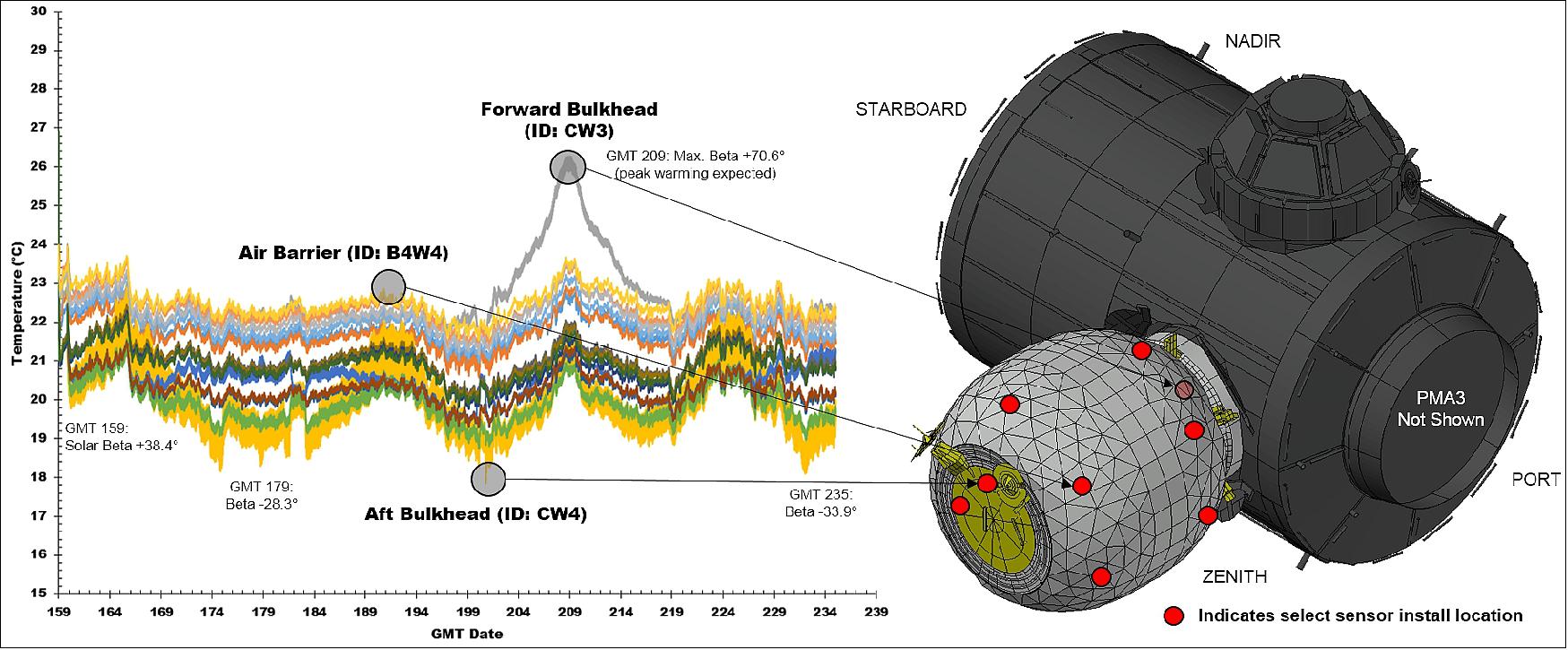
- Space station crew members entered the BEAM twice more in September to reinforce instruments that had loosened since installation, reboot a sensor data-relay laptop that had crashed, take additional samples for return to Earth, and perform tests inside the module to help engineers on the ground better define the structural characteristics of BEAM. NASA Astronaut Kate Rubins entered the BEAM on Sept. 5 to replace the DIDS battery packs after it was determined that drained batteries were disrupting wireless communications with the sensors. Ground operators remotely reconfigured DIDS power settings to a more efficient mode, preventing further disruptions. On Sept. 29, she entered again to conduct a series of modal tests to assess how the structure responds to impacts that cause vibrations and the structure’s ability to dampen the vibrations.
- NASA and Bigelow Aerospace are pleased to report that, overall, BEAM is operating as expected and continues to produce valuable data. Structural engineers at NASA/JSC confirmed that BEAM deployment loads upon the space station were very small, and continue to analyze the module’s structural data for comparison with ground tests and models. Researchers at NASA/LaRC (Langley Research Center) in Hampton, Virginia, have found no evidence of large debris impacts in the DIDS data to date—good news for any spacecraft. And radiation researchers at JSC have found that the dosage due to GCRs (Galactic Cosmic Rays) in BEAM is similar to other space station modules, and continue to analyze local “trapped” radiation particles, particularly from the SAA (South Atlantic Anomaly), to help determine additional shielding requirements for long-duration exploration missions.
- The space station is the world’s primary platform for testing and validating deep space capabilities. “The two-year BEAM mission on ISS provides us with an early opportunity to understand how expandable habitats perform in space,” says Munday. “We’re extraordinarily fortunate to have the the space station and its crew to help demonstrate and assess BEAM technology for use in future exploration missions.”
- The BEAM demonstration is a PPP (Public-Private Partnership) managed by NASA’s AES (Advanced Exploration Systems Division). AES is pioneering innovative approaches and PPPs to rapidly develop prototype systems, advance key capabilities, and validate operational concepts for future human missions beyond Earth orbit. Although the BEAM represents an early demonstration of deep space habitation capabilities, AES is also pursuing deep space habitation development with industry partners through contracts issued under the NextSTEP (Next Space Technologies for Exploration Partnerships) Broad Agency Announcement. Under NextSTEP, four companies (Bigelow Aerospace, Boeing, Lockheed Martin and Orbital ATK) have recently completed cislunar habitation concept studies, and all four plus Sierra Nevada Corporation, are proceeding toward contract negotiations to develop full-size ground prototypes of cislunar habitats. A sixth team, led by NanoRacks, was selected to complete an additional study on the repurposing of upper stages of rockets into habitats.
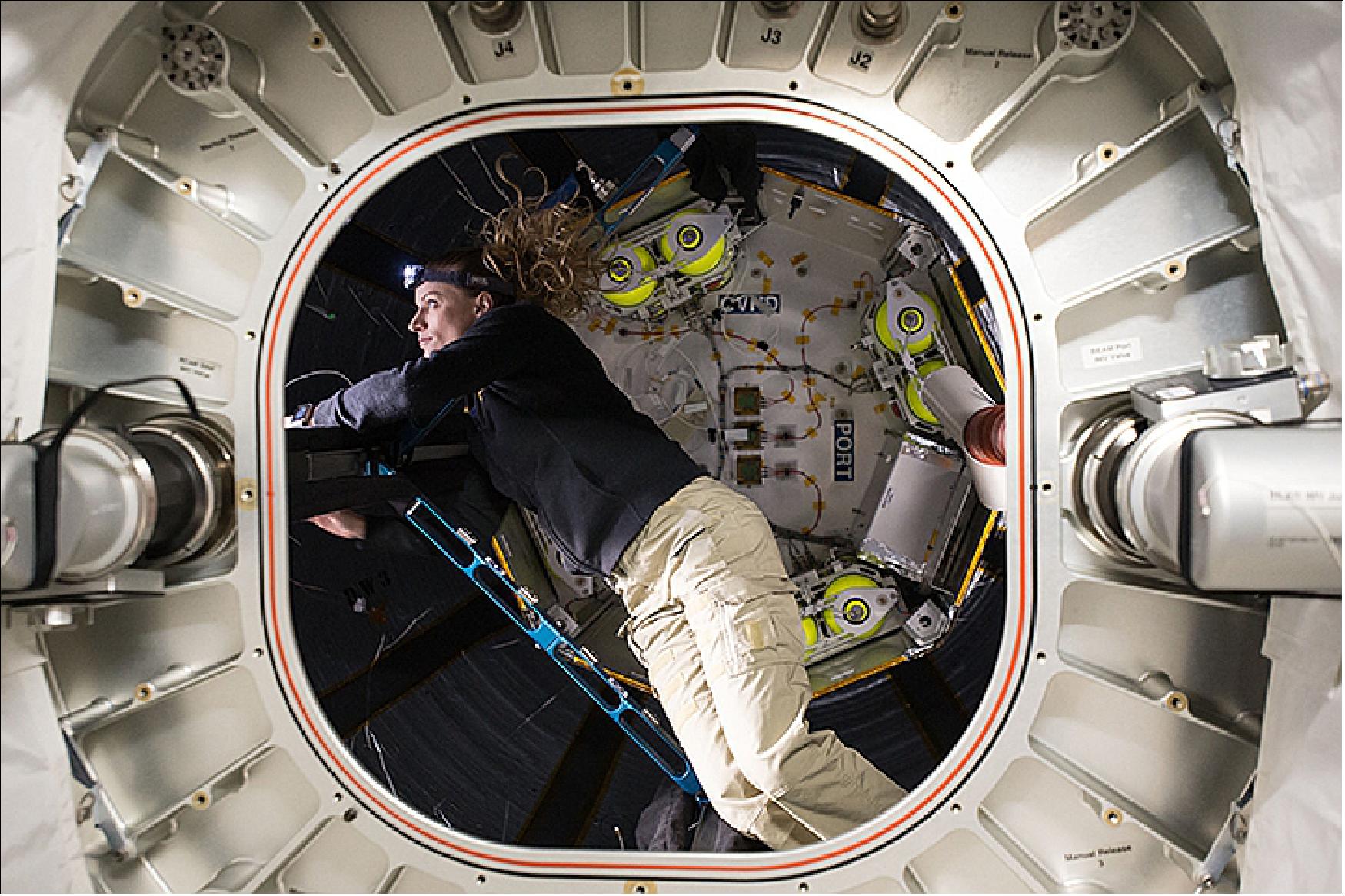

• May 28,2016: Pressurization of the BEAM (Bigelow Expandable Activity Module) began at 13:04 GMT and was complete by 20:34 GMT. Ten minutes later, the ball-shaped room was pressurized to match the pressure of the rest of the International Space Station. — NASA astronaut released short blasts of air into the pod's walls from the orbiting lab using a manual valve. After the expansion was completed, he opened eight air tanks inside BEAM, pressurizing the pod to a level of 1 atmosphere. 24) 25)
- With the BEAM inflation complete, NASA and Bigelow Aerospace will begin a week-long series of leak checks. Only once those leak checks are complete will astronauts be allowed inside BEAM module for the first time.
- According to NASA, this first test of an expandable module will allow investigators to gauge how well the habitat performs and, specifically, how well it protects against solar radiation, space debris and the temperature extremes of space.
- Note: The initial attempt to inflate the module hit a snag on May 26. The habitat was supposed to expand to the size of a small bedroom with breathable air, starting its two-year stint in space. But something had gone wrong. Scientists noticed a problem with BEAM when the pressure to volume ratio wasn't adding up. After analyzing data from the first attempt, the space agency and Bigelow Aerospace believed they identified the problem. The answer was fabric friction according to Bigelow. When BEAM was added to the SpaceX Falcon 9 rocket payload, it may have been packed up longer than expected, according to Bigelow engineers. The fabric-like material that BEAM is made from was compressed, changing the way the material behaved in space temporarily, making it more rigid during the expansion process during that first test. — So NASA and Bigelow Aerospace had decided to stop inflating the habitat on May 26, just to make sure there was no damage to the space station during the process. Their latest retest on May 28 fully expanded and pressurized BEAM.
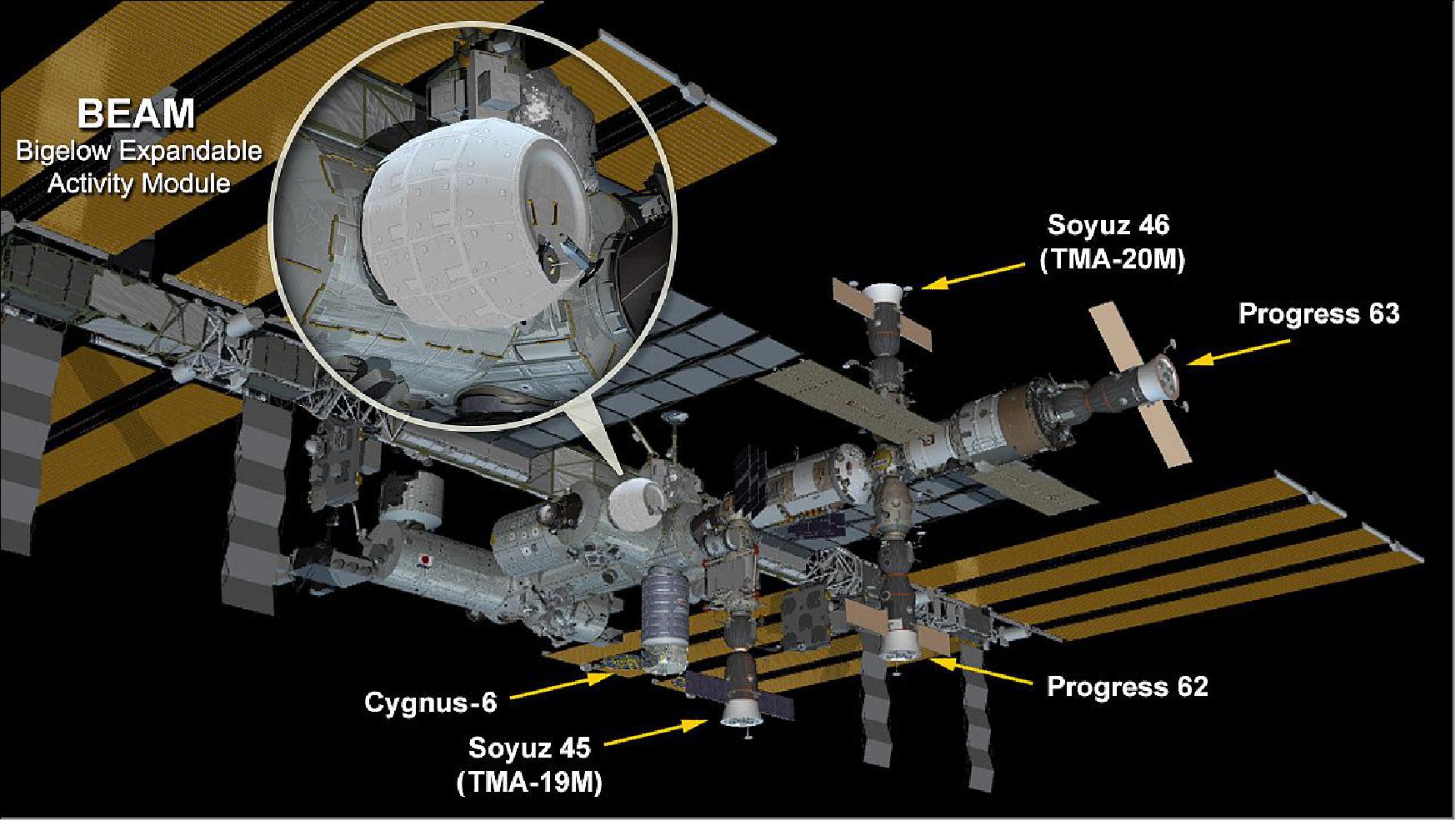
• On April 16, 2016, the ISS grew in size following the successful installation of an experimental new room – the BEAM expandable habitat module. Engineers at NASA/JSC ( Johnson Space Center) in Houston used the space station’s high tech robotic arm to pluck the small module known as BEAM out from the unpressurized rear truck section of the recently arrived SpaceX Dragon cargo freighter, and added it onto the orbiting laboratory complex. 26)
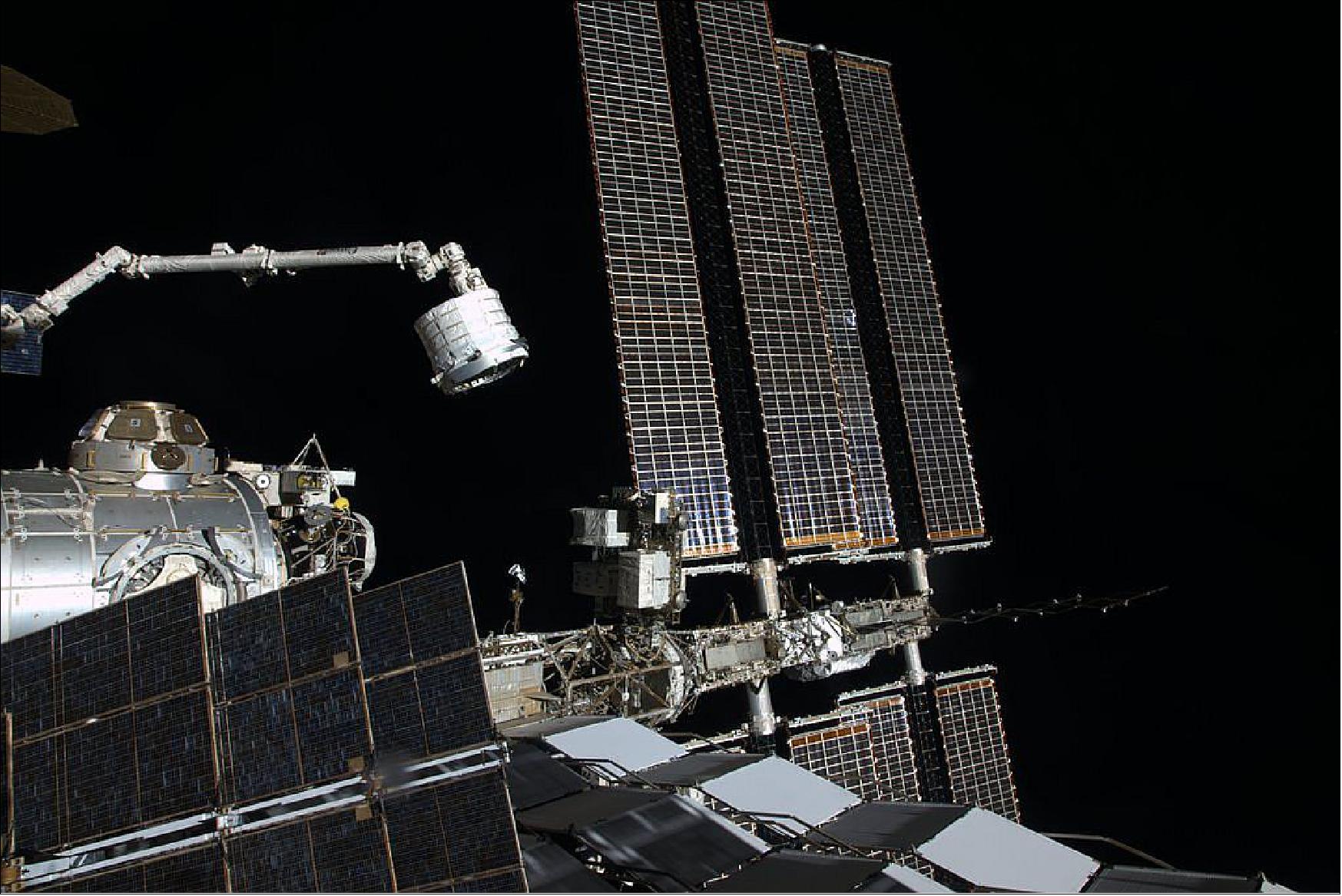
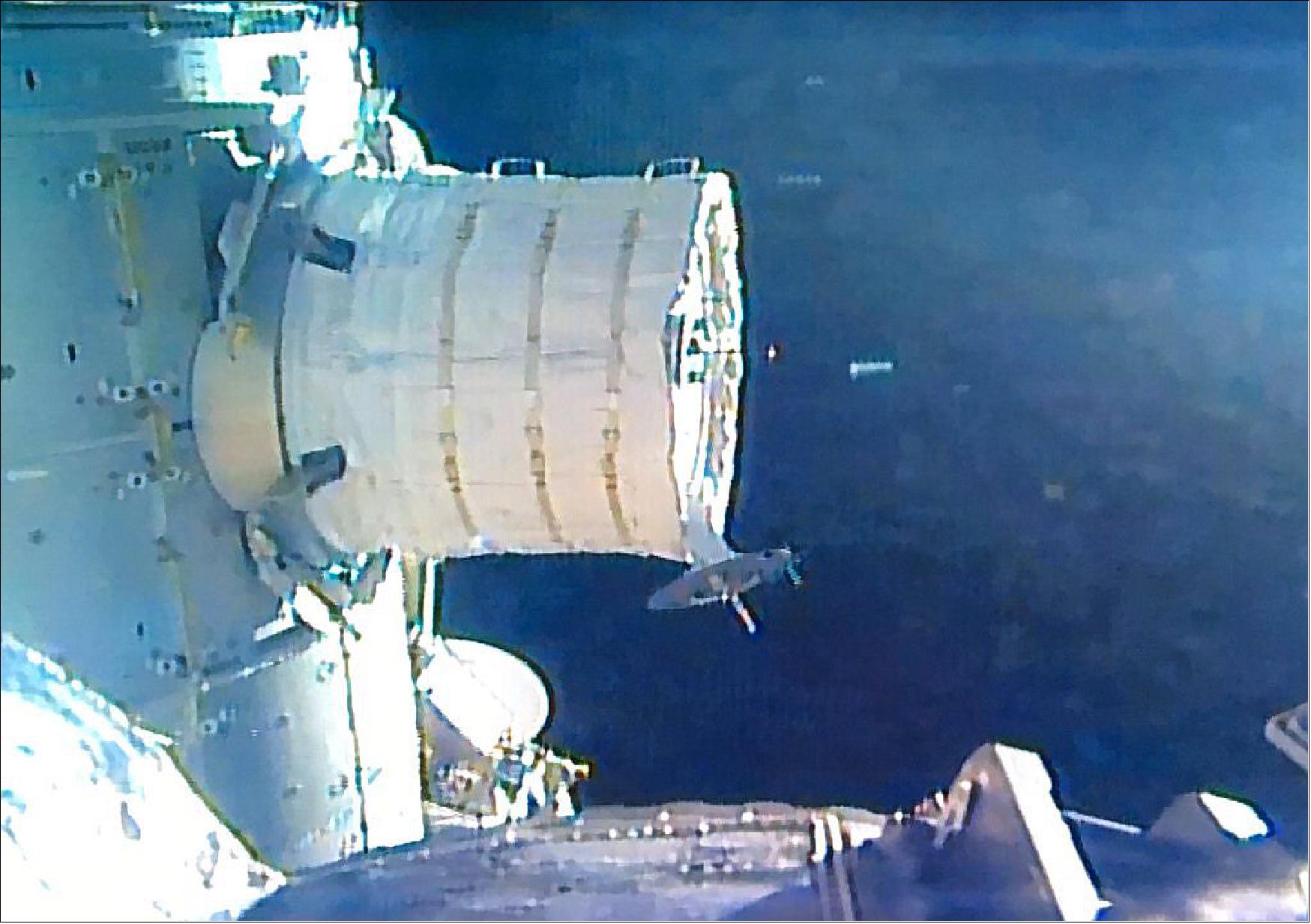
• April 12, 2016: The first human-rated expandable structure that may help inform the design of deep space habitats, is set to be installed to the ISS on April 16. BEAM will be attached to the station’s Tranquility module over a period of about four hours. Controllers in mission control at NASA’s Johnson Space Center in Houston will remove BEAM from the unpressurized trunk of SpaceX’s Dragon spacecraft, using the robotic Canadarm2, and move it into position next to Tranquility’s (Node 3) aft assembly port. NASA astronauts aboard the station will secure BEAM using common berthing mechanism controls. 27)
- At the end of May, the module will be expanded to nearly five times its compressed size. Astronauts will first enter the habitat about a week after expansion and, during a two-year test mission, will return to the module for a few hours several times a year to retrieve sensor data and assess conditions.
- BEAM is an example of NASA’s increased commitment to partnering with industry to enable the growth of the commercial use of space. The BEAM project is co-sponsored by NASA's Advanced Exploration Systems Division and Bigelow Aerospace.
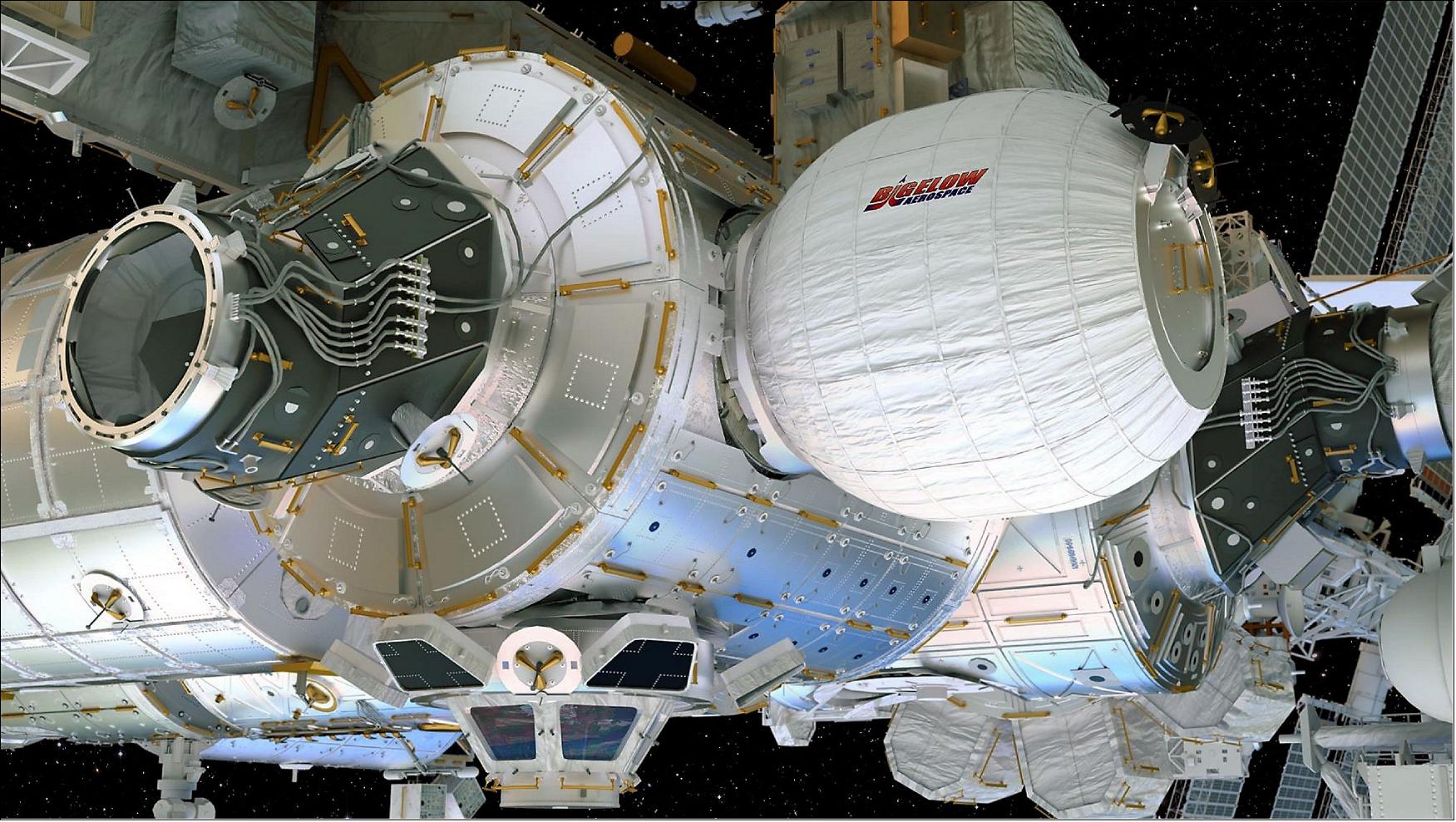
• April 11, 2016: The Dragon CRS-8 vehicle arrived at the station on April 10, 2016 and was captured by British astronaut Tim Peake of ESA with the assistance of NASA’s Jeff Williams using the station’s Canadian-built robotic arm (Canadarm2). Ground controllers at Mission Control in Houston then issued commands to carefully guide the robotic arm holding the Dragon freighter to the Earth-facing port on the bottom side of the Harmony module for its month long stay at the space station. The ship was finally bolted into place at 13:57 GMT as the station flew 400 km over southern Algeria. 28)
- In a historic first, the arrival of the SpaceX Dragon cargo spacecraft marks the first time that two American cargo ships are simultaneously docked to the ISS. The Orbital ATK Cygnus CRS-6 cargo freighter only just arrived on March 26 and is now installed at a neighboring docking port on the Unity module.
- During the two-year test period of BEAM, station crew members and ground-based engineers will gather performance data on the module, including its structural integrity and leak rate. An assortment of instruments embedded within module also will provide important insights on its response to the space environment. This includes radiation and temperature changes compared with traditional aluminum modules.
References
1) “NASA to Test Bigelow Expandable Module on Space Station,” NASA, January 16, 2013, URL: http://www.nasa.gov/mission_pages/station/news/beam_feature.html
2) Trent J. Perrotto, “NASA To Test Bigelow Expandable Module On Space Station,” NASA, Release: 13-024, Jan. 16, 2013, URL: http://www.nasa.gov/home/hqnews/2013/jan/HQ_13-024_Bigelow_ISS_Module.html
3) Irene Klotz, “Inflatable Bigelow Module To Fly to Space Station in 2015,” Space News, Jan. 21, 2013, p. 6
4) “The first private space habitat is here,” Bigelow, URL: http://bigelowaerospace.com/beam/
5) ”Bigelow Expandable Activity Module (BEAM),” NASA, Nov. 25, 2015, URL: http://www.nasa.gov/mission_pages/station/research/experiments/1804.html
6) Pete Harding, Chris Bergin, “Expanding on Bigelow’s inflatable module for the ISS,” NASA, January 12, 2013, URL: http://www.nasaspaceflight.com/2013/01/expanding-on-bigelows-inflatable-module-iss/
7) Leonard David, “International Space Station Could Get Private Inflatable Room,” Space.com, Jan. 26, 2011, URL: http://www.space.com/10686-nasa-bigelow-module-international-space-station.html
8) Leonard David, “Inside NASA's Bigelow deal for inflatable space station room,” NBC News, Jan. 16, 2013, URL: http://www.nbcnews.com/id/50486752/ns/technology_and_science-space
/t/inside-nasas-bigelow-deal-inflatable-space-station-room/#.UukR4_vnNeM
9) T. Dinerman, “Genesis and the future space hotel,” The Space Review, July 17, 2006, http://www.thespacereview.com/article/660/1
10) “TransHab Concept,” http://spaceflight.nasa.gov/history/station/transhab/
11) D. Schrimpsher, “Interview: TransHab developer William Schneider,” The Space Review, Aug. 21, 2006, http://www.thespacereview.com/article/686/1
12) Mark Thompson, “Bigelow's inflatable space stations,” Aug. 27, 2012, URL: http://www.sen.com/feature/bigelow-aerospace-and-the-inflatable-space-stations.html
13) Matt Williams, “Bigelow Inflatable Module to be Added to Space Station in 2015,” Universe Today, Oct. 13, 2014, URL: http://www.universetoday.com/115135/
the-bigelow-expandable-activity-module-an-inflatable-room-for-astronauts/
14) Alan Boyle, “Bigelow Aerospace Shows Off Its Vision for Expandable Space Stations,” NBC News, URL: http://www.nbcnews.com/science/space/
bigelow-aerospace-shows-its-expandable-space-station-future-n322521
15) “New Expandable Addition on Space Station to Gather Critical Data for Future Space Habitat Systems,” NASA, March 12, 2015, URL: http://www.nasa.gov/content/new-expandable-addition-on-space-station-to-gather-critical-data-for-future-space-habitat/#.VQ09ROH-b_U
16) Charles Bolden, John P. Holdren, “American-Made Technology and Innovative Commercial Partnerships Advance Our Journey into the Solar System,” March 12, 2015, URL: https://web.archive.org/web/20150405045620/https://blogs.nasa.gov/bolden/2015/03/12/american-made-technology-and-innovative-commercial-partnerships-advance-our-journey-into-the-solar-system/
17) Tabatha Thompson, Dan Huot, ”NASA Cargo Headed to Space Station Includes Habitat Prototype, Medical Research,” NASA, Release 16-043, April 8, 2016, URL: http://www.nasa.gov/
press-release/nasa-cargo-headed-to-space-station-includes-habitat-prototype-medical-research
18) Jeff Foust, ”Bigelow Aerospace transfers BEAM space station module to NASA,” SpaceNews, 21 January 2022, URL: https://spacenews.com/bigelow-aerospace-transfers-beam-space-station-module-to-nasa/
19) Mark Garcia, ”NASA Extends Expandable Habitat's Time on the International Space Station,” NASA, 4 Dec. 2017, URL: https://www.nasa.gov/feature/nasa-extends-beam-s-time-on-the-international-space-station
20) ”NASA May Extend BEAM’s Time on the International Space Station,” NASA, Oct. 3, 2017, URL: https://www.nasa.gov/feature/nasa-may-extend-beam-s-time-on-the-international-space-station
21) ”A Look Inside the Space Station's Experimental BEAM Module,” NASA, Aug. 4, 2017, URL: https://www.nasa.gov/image-feature/a-look-inside-the-space-stations-expandable-beam-module
22) Erin Mahoney, ”First Year of BEAM Demo Offers Valuable Data on Expandable Habitats,” NASA, May 29, 2017, URL: https://www.nasa.gov/feature/first-year-of-beam-demo-offers-valuable-data-on-expandable-habitats
23) Erin Mahoney, ”BEAM Update: Expandable Habitat Reveals Important Early Performance Data,” NASA, Nov. 21, 2016, URL: https://www.nasa.gov/feature/
beam-update-expandable-habitat-reveals-important-early-performance-data
24) ”NASA inflates spare room in space,” Space Daily, May 28, 2016, URL: http://www.spacedaily.com/reports/NASA_inflates_spare_room_in_space_999.html
25) Pete Harding, ”ISS controllers complete BEAM module expansion,” NASASpaceflight.com, May 28, 2016, URL: https://www.nasaspaceflight.com/2016/05/iss-inflatable-module-beam-expansion/
26) Ken Kremer, ”Space Station Gets Experimental New Room with Installation of BEAM Expandable Habitat,” Universe Today, April 16, 2016, URL: http://www.universetoday.com/128411/
space-station-gets-experimental-new-room-with-installation-of-beam-expandable-habitat/
27) Cheryl Warner, Dan Huot, ”NASA to Attach, Test First Expandable Habitat on International Space Station,” NASA, April 12, 2016, URL: http://www.nasa.gov/press-release/
nasa-to-attach-test-first-expandable-habitat-on-international-space-station
28) Ken Kremer, ”SpaceX Dragon Carrying New Inflatable Room Captured and Mated to Space Station,” Universe Today, April 11, 2016, URL: http://www.universetoday.com/128332
/spacex-dragon-carrying-new-room-captured-and-mated-to-space-station/
29) Garcia, Mark. “Partners Extend International Space Station for Benefit of Humanity – Space Station.” NASA Blogs, 27 April 2023, https://blogs.nasa.gov/spacestation/2023/04/27/partners-extend-international-space-station-for-benefit-of-humanity/
The information compiled and edited in this article was provided by Herbert J. Kramer from his documentation of: ”Observation of the Earth and Its Environment: Survey of Missions and Sensors” (Springer Verlag) as well as many other sources after the publication of the 4th edition in 2002. Comments and corrections to this article are always welcome for further updates (eoportal@symbios.space).